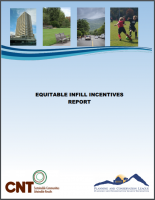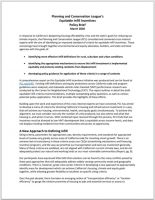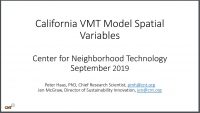Equitable Infill Program
Read the Equitable Infill Incentives Report
California is currently facing a major housing crisis. California will need to build 1.8 million new homes and double its current rate of development in order to keep up with the growing population [1]. California also has a lack of affordable housing. Both housing and rent prices can be double the amount an average American spends outside of California [2]. This has caused California to have the biggest homeless population in the country, with over 150,000 people currently living on the streets and the rate steadily increasing [3]. Additionally, due to a lack of housing in urban centers, the housing shortage promotes long commutes, which in turn contributes to GHG emissions due to there being more cars on the road [4]. Although Governor Newsom proposed to spend 1.75 billion to combat the housing crisis, much more will need to be done to keep up with the growing demand [5].
PCL is working with cross-interest advocates, builders, and agencies to make sure that the housing crisis is resolved in a way that also addresses our climate and equity goals. One such solution is to promote infill development, which is when housing is built on vacant or under-used lots in urban areas instead of on undeveloped land. This not only decreases sprawl and protects natural and working land from development, but also decreases Vehicle Miles Traveled (VMT) and associated GHG emissions due to the proximity of the new housing to jobs, schools, services, and transportation options. Yet, infill investment can also add to gentrification and displacement pressures on lower-income residents in these communities. Developing incentives that can overcome the many barriers to infill – high costs, site contamination, lack of zoning capacity, neighborhood resistance – while protecting existing residents from displacement, has been an intractable challenge for California.
Our Equitable Infill Incentives Report resolves to develop a new standard of criteria for infill incentives that will promote development that is both sustainable and equitable in urban, suburban, and rural contexts.
There are many past approaches to defining infill that in many cases are inconsistent, outdated, unproductive, or not adequately protective of our environment or our communities. Likewise, there have been multiple approaches to preserving equity in our housing investments, but the agreed-to standard of base-line criteria of inclusionary and anti-displacement requirements has never been firmly established.
PCL compiled a multitude of examples from existing statutes, regulations, and grant program guidelines for our cross-interest roundtable’s consideration, in pursuit of a more productive and protective metric for defining infill. These discussions were informed by mapping and analysis conducted by the Center for Neighborhood Technology (CNT) that examines the “location efficiency” of infill areas by vehicle miles traveled (VMT) performance, including household income factors. The report includes a summary of CNT’s analysis, and the full set of state-wide mapping can also be viewed below.
We then repeated the process to analyze the many existing approaches to equity protections that should be coupled with infill incentives. Building upon a collaborative effort conducted by our partner ClimatePlan to develop a policy platform for “Investment Without Displacement,” we sought to translate this policy guidance into specific inclusionary and anti-displacement criteria. and then presented this problem to our allies in a Roundtable meeting and collected input on what parts of the definitions should be included in the final definition. The next step was to include as part of the definition a series of incentives that would prioritize sustainable and affordable development. We specifically focused on adding inclusionary and anti-displacement protections to make sure that the new development does not promote patterns of gentrification and segregation. Using a set of policy guidelines for investment without displacement developed by our partners at ClimatePlan, we proposed this issue as a series of questions at our next Roundtable meeting and gathered their thoughts on how to properly include these provisions in our definition of infill.
PCL strongly believes that we must address our housing goals in alignment with our environmental, climate, health, and equity goals simultaneously. This can only be possible by focusing our resources on Low-VMT infill development, coupled with inclusionary and anti-displacement protections for these existing communities. Our report outlines draft recommendations for criteria that we will continue to refine with our cross-interest stakeholders with the aim of establishing a new standard for equitable infill incentives and the way California directs its housing and infrastructure investment.



